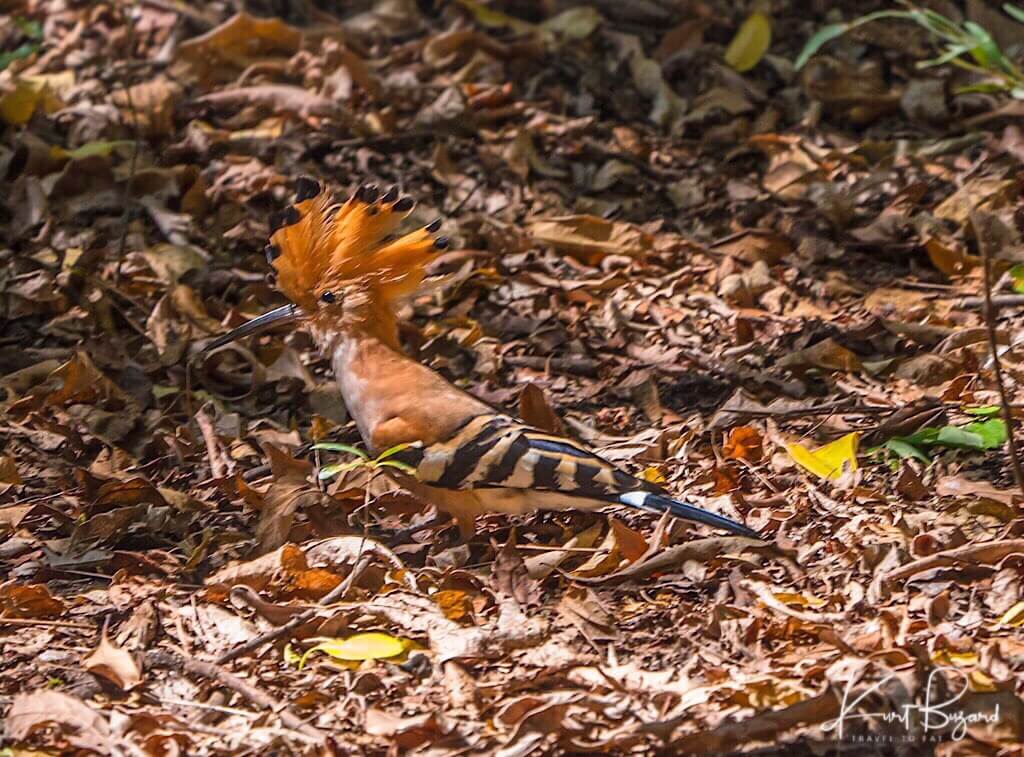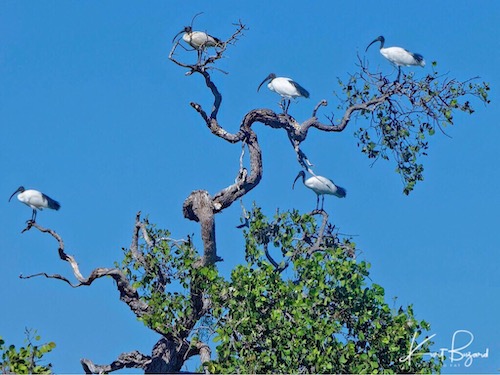
When I visited Madagascar the focus was really on chameleons and lemurs. There was little time to explore the beautiful and unique birds of Madagascar. What I lost in numbers I gained in quality. The birds I did see were colorful and unique many of which found only on Madagascar. The distance from Africa to Madagascar and the surrounding islands does not seem that far for birds but they seem evolve in isolation creating beautiful riffs on familiar forms. The Malagasy Sacred Ibis seen above is a good example. Long thought to be a minor variation on the African Sacred Ibis, new research established them as a separate species and renewed focus on their habitat and numbers. Unlike the African Ibis, they seem to prefer mangrove swamps and are rare away from the coast and in freshwater settings. In fact they are so sparsely distributed along the west coast of Madagascar that there may be fewer than 2000 left in the wild. Even for birds, Madagascar may be far more like the Galápagos than we previously thought.
Malagasy Pygmy Kingfisher
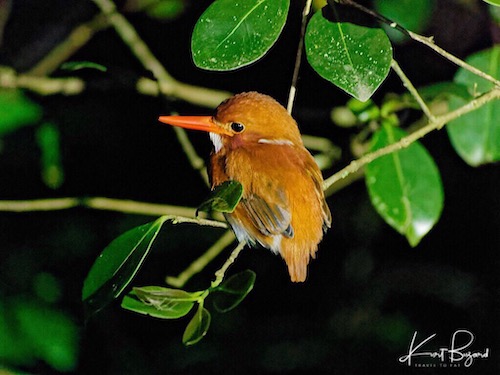
The Madagascar Pygmy Kingfisher (Corythornis madagascariensis, syn. Ispidina madagascariensis, syn. Ceyx madagascariensis) is endemic to the forests of Madagascar. It has a terrestrial (non-riverine) lifestyle and feeds on insects and other invertebrates. It is rather widely distributed and can be found both in eastern rain- and western dry forests. However, it is nowhere very common. The first formal description of the Madagascan pygmy kingfisher was by the Swedish naturalist Carl Linnaeus in 1758 in the twelfth edition of his Systema Naturae under the binomial name Alcedo madagascariensis. Although it has been placed in the genera Ceyx and Ispidina in the past, a study of its molecular phylogenetic relationships with other genera in the region suggests it is best treated as a member of the genus Corythornis. This is a small bird, 5 in (13 cm) with rufous upper parts and white underparts and a white patch in the neck. We found him at night in a small bush in Ranomafana National Park.
Malagasy Paradise Flycatcher
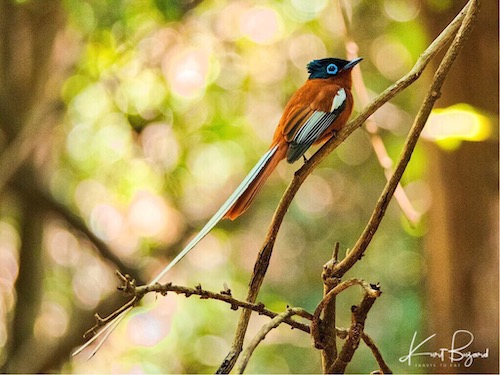
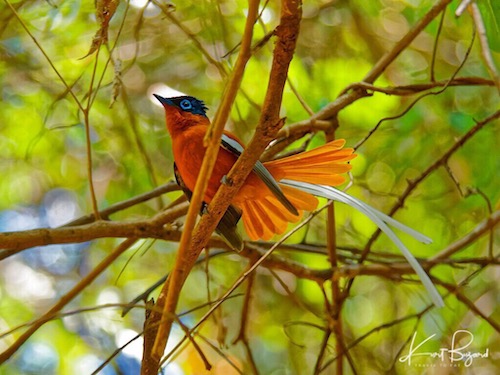
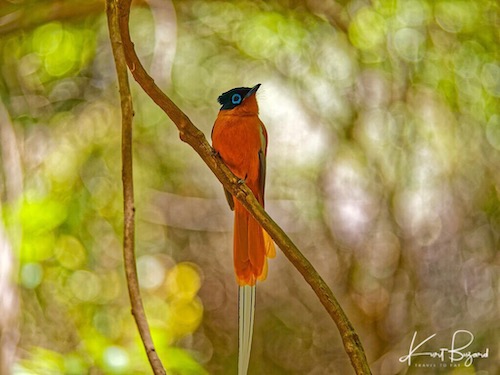
The Malagasy Paradise Flycatcher (Terpsiphone mutata) is thought to have evolved from African ancestors, as it appears to be more closely related to the African paradise flycatcher than the Indian paradise flycatcher. Its natural habitats are subtropical or tropical dry forest and subtropical or tropical moist lowland forest. The Malagasy Paradise Flycatcher is a medium-sized bird, measuring 7.1 in (18 cm) in length and weighing between 0.43 and 0.43 oz (12.1 and 12.3 gm). Males have long tail plumes, which can add as much as 18 cm (7.1 in) to their overall length. The female is largely rufous-orange, with a black head and nape. The flight feathers on her wings are black with rufous edges, and she has a thin, light blue eyelid wattle. This species is a regional endemic found on Madagascar, Mayotte and the Comoros islands. It is common in all native forest types except montane forest, at elevations ranging from sea level to 1,600 m (5,200 ft). It also occurs, though less frequently, in other wooded habitats, including plantations, gardens and secondary forest. I must say, this is a spectacular bird to see in person, the trailing white tail feathers and the bright blue around the eyes takes your breath away.
Madagascar Hoopoe
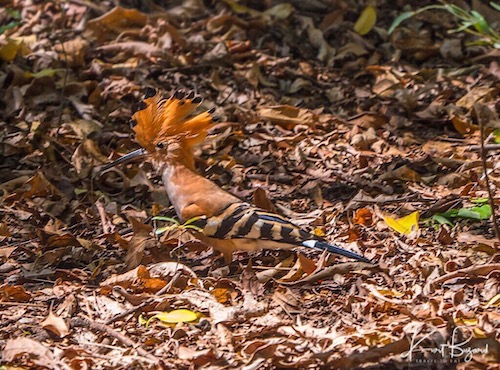
The Madagascan hoopoe (Upupa marginata) is a species of hoopoe in the family Upupidae. It was previously considered a subspecies (Upupa epops marginata) of the hoopoe, but was split due to its vocalisations and small differences in plumage. Hoopoes are colorful birds found across Afro-Eurasia, notable for their distinctive “crown” of feathers. Three living and one extinct species are recognized, though for many years all were lumped as a single species—Upupa epops. Formerly considered a single species, the hoopoe has been split into three separate species: the Eurasian hoopoe, Madagascan hoopoe and the resident African hoopoe. The Madagascar subspecies also makes use of more dense primary forest. The modification of natural habitats by humans for various agricultural purposes has led to hoopoes becoming common in olive groves, orchards, vineyards, parkland and farmland, although they are less common and are declining in intensively farmed areas.
Sakalava Weaver

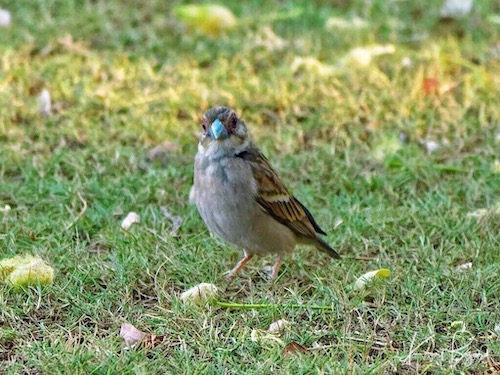
The small, 0.9 oz (25 g), Sakalava Weaver (Ploceus sakalava) only occur in Madagascar. As the name indicates, they belong to the weaver birds and are widely distributed around the island in the areas the Sakalava Malagasy tribe lives. The species epithet sakalava is derived from the Sakalava tribe, whose name means “people of the long valleys”. This is mainly western Madagascar; from the deep, hot and dry South to the North. The adult male has a yellow head and upper breast during the breeding season, with a pale grey belly and light and brown wings with white wing-tips. The male has distinctive red eye-rings and silver bill extending with a ‘V’ shape into the forehead. The non-breeding male has a dark brown head and pale grey breast, flanked with white. The female has the appearance more of a house sparrow with pale almost white breast and duller slightly pink bill. The female also has a very pale eye-ring and sometimes small flashes of red around the eye.
Madagascar Fody

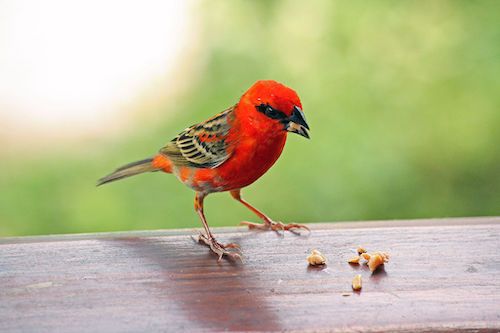
If I had not included a picture of the male Madagascar Fody you would probably not have taken a second look at the female. The Red Fody (Foudia madagascariensis), sometimes known as the Madagascar Fody, Red Cardinal Fody or Common Fody, is a small bird native to Madagascar and introduced to various other islands in the Indian Ocean. The bright red breeding plumage of this common Malagasy bird makes identification easy. However, the non-breeding males and females are easily mistaken for other species such as Sakalava Weavers. Sadly, I did not see the bright red male and included a photo from Wikipedia for reference. It is a common bird found in forest clearings, grasslands and cultivated areas, but not in dense forest. In Madagascar it is regarded as a pest of rice cultivation.
Red Tailed Vanga
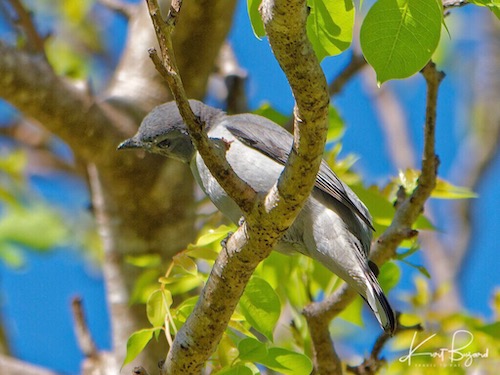
The Female Red-Tailed Vanga (Calicalicus madagascariensis) is endemic to Madagascar where it frequents several types of forests in N, W and E of the island. The Red-tailed Vanga is sexually dimorphic. The male has a black band across the eye, grey head and white underparts. The tail has a conspicuous amount of red brown. The adult female is duller overall. The head is pale grey with conspicuous white eyering. The upperparts are olive-brown with rufous rump and uppertail-coverts. The upperwing is dark brown. The female can be confused with the Common Newtonia (Newtonia brunneicauda) which is a small bird with greyish-brown upper parts, tannish-white underparts, a black bill and golden-yellow eyes. Since this bird has dark eyes, I went with the Red Tailed Vang’s. Its natural habitats are subtropical or tropical dry forests and subtropical or tropical moist lowland forests. Although it is a common bird all over Madagascar, it prefers primary forest. The Vangas are an example of adaptive radiation, having evolved from a single founding population into a variety of forms adapted to various niches occupied by other bird families in other parts of the world in Madagascar. They differ in size, colour and bill shape but are similar in skull shape and bony palate structure. They are small to medium-sized birds, varying from 12 to 32 cm in length. Many have strong, hooked bills similar to those of shrikes. The helmet vanga has a particularly large bill with a casque on top. Other species, such as the newtonias, have a small, thin bill.
Malagasy Bulbul
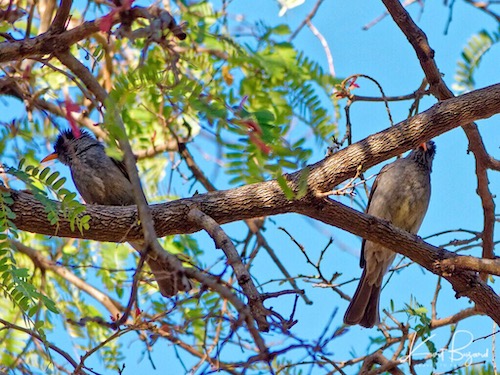
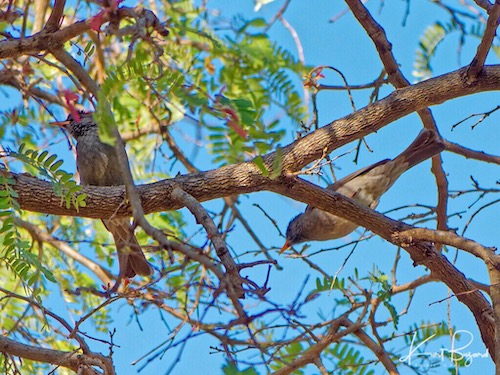
The Malagasy Bulbul (Hypsipetes madagascariensis) is a species of songbird in the bulbul family, Pycnonotidae. It is found on Madagascar and other regional islands in the south-western Indian Ocean. This species has a very large range, and hence does not approach the thresholds for Vulnerable under the range size criterion. Bulbuls are short-necked slender birds. The tails are long and the wings short and rounded. In almost all species the bill is slightly elongated and slightly hooked at the end. They vary in length from 13 cm for the tiny greenbul to 29 cm in the straw-headed bulbul. Overall the sexes are alike, although the females tend to be slightly smaller. The soft plumage of some species is colorful with yellow, red or orange vents, cheeks, throat or supercilia, but most are drab, with uniform olive-brown to black plumage. Species with dull coloured eyes often sport contrasting eye-rings. Some like the Malagasy Bulbul, have very distinct crests. I personally think the crest on the Malagasy Bulbul looks like a black bottle brush. Bulbuls are highly vocal, with the calls of most species being described as nasal or gravelly. One author described the song of the brown-eared bulbul as “the most unattractive noises made by any bird”.
Madagascar Wagtail
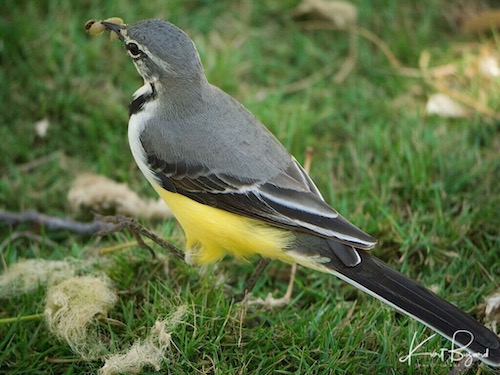
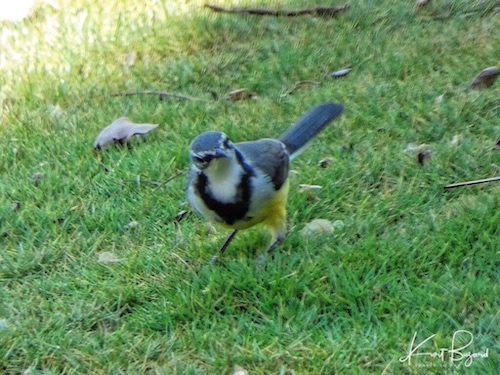
The Madagascan wagtail (Motacilla flaviventris) is a large, elegant and slender wagtail which has grey upperparts, a white breast and a yellow belly. There is a black band across the breast and the long tail has a dark centre and white outer tail feathers. There is short white supercilium. Juveniles have a less conspicuous breast band and a fainter supercilium. The body length is 19 cm (7.5 in). The Madagascan wagtail is endemic to Madagascar where it is found throughout the island. It is common and widespread and most common in the east of the island and on the central plateau; it is less numerous in the north and west, and rare in the south. It is typically found around water, such as rivers, lakes and seashores, also in open areas such a rice paddies and gardens. I saw this one in the Anjajavy Reserve.
Malagasy Coucal
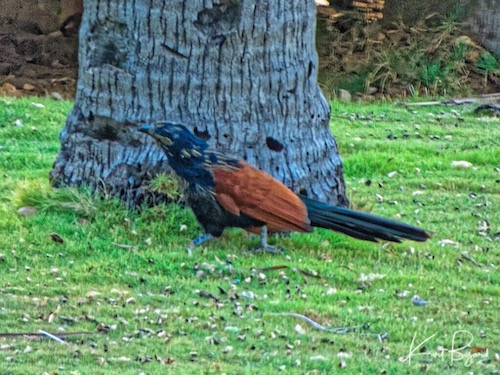
The Malagasy Coucal (Centropus toulou) is a medium-sized bird with the adult length being in the range 16 to 20 in (40 to 50 cm). The male is smaller than the female, weighing about 5oz (140 gm) to the female’s 7 oz (190 gm), but otherwise the sexes are similar in appearance. In breeding plumage the bird is black, glossed with green, except for the tips of its wings which are brown and its mid and lower back which are reddish brown. In non-breeding plumage the head, neck and throat are brown streaked with cream, the wings reddish brown, the uppertail coverts black with some pale barring, the tail blackish brown with faint barring and the belly blackish brown. The iris is red, the bill black in breeding plumage and pale in non-breeding plumage, and the feet are grey to black. The Malagasy coucal inhabits thick, bushy places. It is a predator and feeds in the undergrowth and on the ground by pursuing and pouncing on its prey. Its diet includes large insects, spiders, molluscs and other invertebrates, geckos, skinks, chameleons and rodents, all of which it swallows whole. It pries off loose bark on trees to search for lizards or other prey hiding underneath. It has been recorded raiding bird nests and devouring the eggs and nestlings.
Malagascan Magpie-Robin
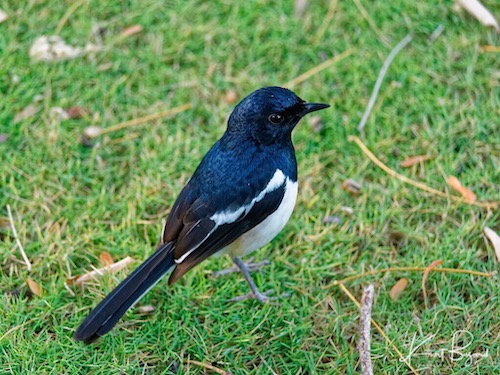
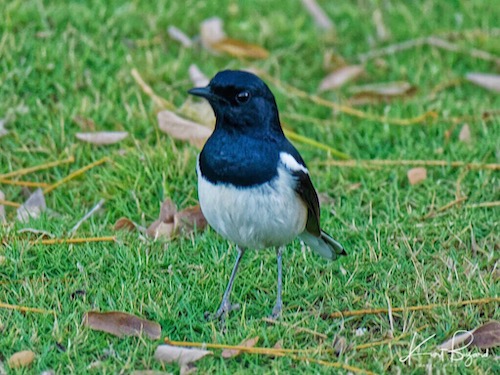
The Madagascan Magpie-Robin (Copsychus albospecularis) is a species of chat in the Old World flycatcher family Muscicapidae. It is also called the Madagascar Magpie-Robin. The Madagascan magpie-robin is closely related to the Seychelles magpie-robin and the Oriental magpie-robin, and may form a superspecies with them. The species is endemic to Madagascar, where it is found across the island. Its distribution is sometimes scattered as it occupies a wide range of habitats and can be very common or fairly rare depending on this. Three subspecies have been described, the one in the Anjajavi Reserve, where I saw these is Copsychus albospecularis albospecularis. The Madagascan Magpie-Robin is 7.1 in (18 cm) in length and weighs 0.74–0.85 oz (21 to 24 gm). The plumage varies by sex; the male of the nominate subspecies has all-black plumage with a white shoulder patch and the female has a grey-brown crown, back and tail, grey-breast and throat and rufous wings and rump. The males of the other subspecies have more white on the wings and a white abdomen.
Crested Drongo
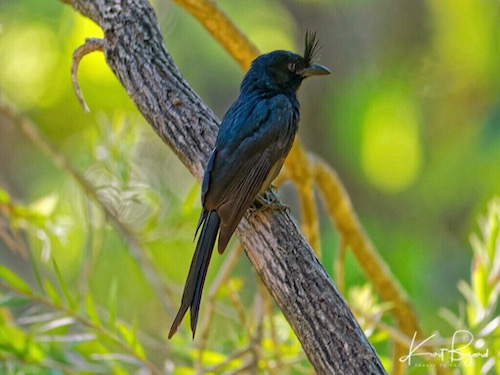

The crested drongo (Dicrurus forficatus) is black with a bluish-green sheen, a distinctive crest on the forehead and a forked tail. There are two subspecies; D. f. forficatus is endemic to Madagascar and D. f. potior, which is smaller, is found on the Comoro Islands. Its habitat is lowland forests, both dry and humid, and open savannah country. It is a common bird and the IUCN has listed it as “least concern”. this is a distinctive medium sized 10 in (26 cm) bird that is hard to confuse with anything else. A bold, aggressive bird that often perches in the open and does not hesitate to harass Pied Crows, raptors, and other large birds. This species is not even particularly afraid of humans, giving me endless portrait photo opportunities.
Vasa Parrot
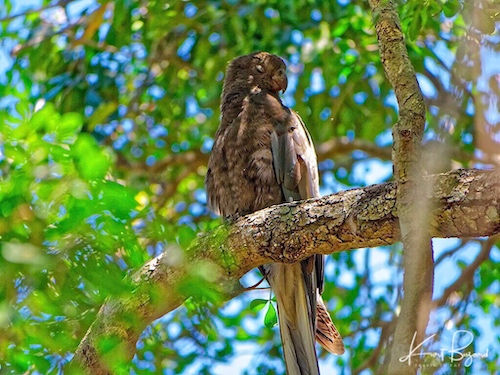

The Vasa Parrots (Coracopsis vasa) are notable in the parrot world for their peculiar appearance, which includes extremely truncated bodies with long necks, black to grey feathers and a pink beak. The skin of both female and male vasas turns yellow during the breeding season, and there is often feather loss. However, in females the feather loss can result in complete baldness. Another interesting feature of the females breeding physiology is when her feathers, which are usually black to grey, turn brown without a moult. This is caused by the redistribution of melanin, which is the pigment that makes the vasas’ feathers black. In addition to their appearance they possess aspects of their physiology that make them completely unique amongst parrots. Vasa chicks are known to hatch after only 18–20 days of incubation, which is highly irregular as parrots of the vasa size range tend to take up to 30 days to hatch. The Greater Vasa Parrot (Coracopsis vasa) is one of two species of Vasa Parrot, the other being the Lesser Vasa Parrot (Coracopsis nigra). Both can be found throughout Madagascar and honestly they are hard to tell apart.
Madagascar Gray Headed Lovebird
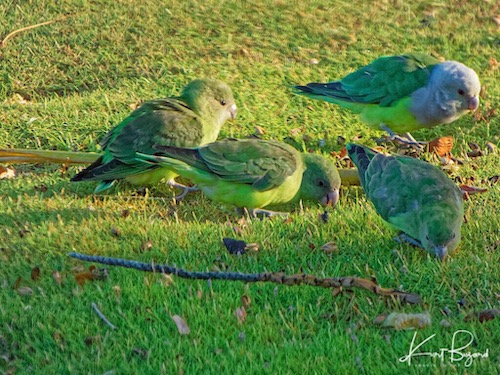

The Grey-Headed Lovebird or Madagascar Lovebird (Agapornis canus) is a small species of parrot of the lovebird genus. It is a mainly green parrot. The species is sexually dimorphic and only the adult male has grey on its upper body. They are native on the island of Madagascar and are the only lovebird species which are not native on the African continent. They are the smallest of the lovebird species. It is rarely seen in aviculture and it is difficult to breed in captivity. The grey-headed lovebird is one of the smallest species of the lovebird genus, being 5 in (13 cm) long and weighing about 1–1.3 oz (30–36 gm). Its beak and feet are pale grey. The species is sexually dimorphic: the adult female is entirely green, with a dark green back and wings, a bright green rump, and a paler green chest; the adult males are similarly colored, except that their entire head and upper chest are a pale grey. These little beauties are small an difficult to capture on film. Grey-headed lovebirds are strong fliers, and when open, their wings seem larger in relation to their bodies than those of the peach-faced lovebird. They can develop good speed quite quickly and effortlessly, and turn smoothly, though they are not as nimble in the air as the peach-faced lovebirds.
Purple Heron
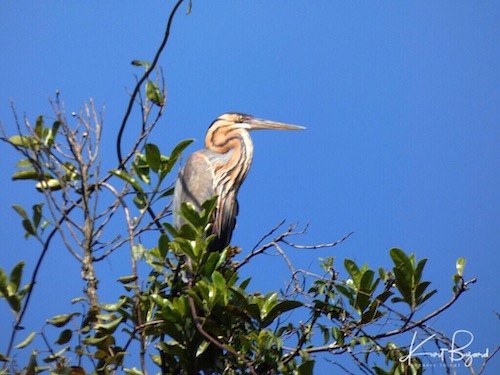
The purple heron (Ardea purpurea) is a wide-ranging species of wading bird in the heron family, Ardeidae. The scientific name comes from Latin ardea “heron”, and purpureus, “colored purple”. It breeds in Africa, central and southern Europe, and southern and eastern Asia. The Western Palearctic populations migrate between breeding and wintering habitats whereas the African and tropical-Asian populations are primarily sedentary, except for occasional dispersive movements. Despite its English common name, the purple heron actually has a chestnut-red head and neck with striking vertical black stripes, grey shoulders and outer-wings, and a rich chestnut stomach and inner-wings. The Spanish name for the purple heron is garza imperial, which translates as the ‘imperial heron’, perhaps a more suitable name for this vibrant-looking species. There are three or four subspecies, the one for Madagascar is Ardea purpurea madagascariensis.
Malagasy Sacred Ibis
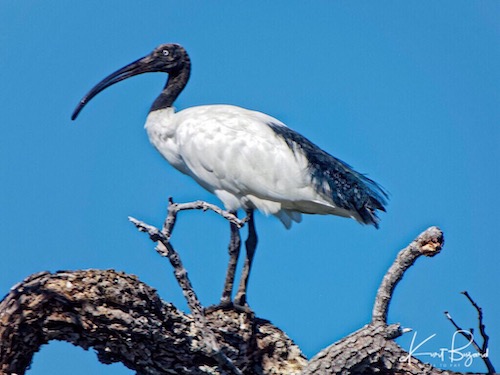
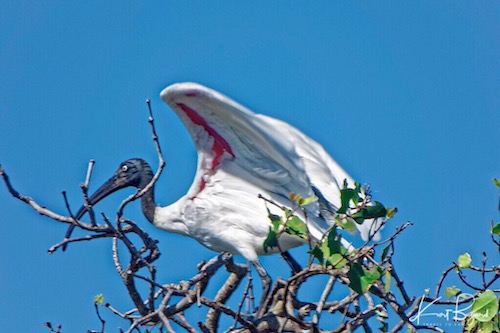
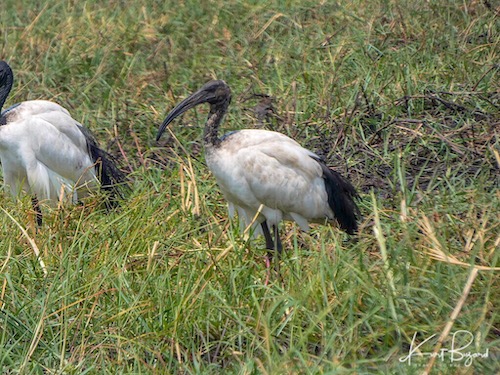
The Malagasy Sacred Ibis (Threskiornis bernieri) was formerly considered a subspecies of the African Sacred Ibis (Threskiornis aethiopicus). It is now however classified as a separate species from the African sacred ibis due to considerable differences observed in the former’s ecology and morphology. It is hypothesized that the Malagasy Sacred Ibis evolved from the African sacred ibis when the latter supposedly spread to and colonized Madagascar from mainland Africa. The adult stands 25–35 in (65–89 cm) tall, with a wingspan of 44–49 in (112–124 cm). The plumage is predominantly white, often with brownish-yellow staining. There are also black ornamental plumes on the back with a blue or green gloss. The bill, head, neck and legs are black. The big difference between the Malagasy Sacred Ibis and the African Sacred Ibis are the eyes, slate grey/blue like James Bond. The Madagascar sacred ibis is confined to the west coast of Madagascar and Aldabra, a coral atoll approximately 400 kilometres north-west of Madagascar. The two locations harbor different subspecies of the bird, with Threskiornis bernieri bernieri found on Madagascar and Threskiornis bernieri abbotti found on Aldabra. The main threats to the Madagascar Sacred Ibis come from the harvesting of its eggs, the trapping of adults and the taking of chicks for human consumption. Estimates of this species’ population on Madagascar in 2006, indicated that there were less than 2000 mature individuals, a number that is simply too small to support the current levels of exploitation. Unfortunately, the Madagascar Sacred Ibis displays no fear of humans while nesting or roosting, and is, therefore, an easily obtainable source of food for hunters. While legislation on hunting does exist in Madagascar, it has proved ineffective in reducing hunting pressure on this species, with surveys indicating that populations of the Madagascar Sacred Ibis are significantly declining.
Madagascar Crested Ibis
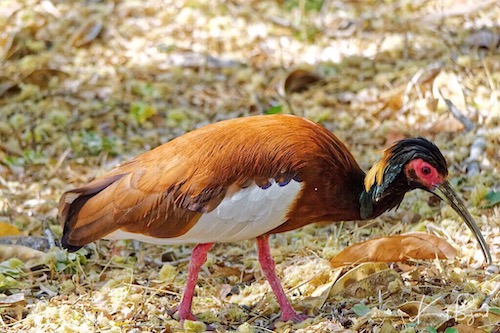
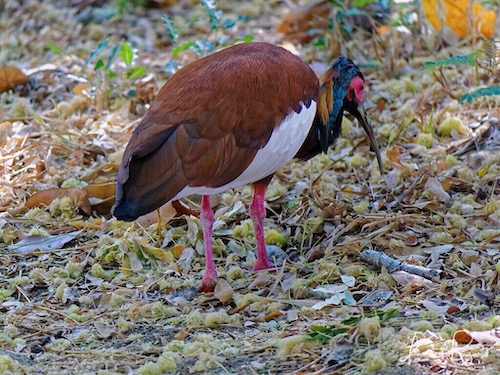
The Madagascan Crested Ibis (Lophotibis cristata), also known as the Madagascar Ibis, white-winged ibis or crested wood ibis, with a length of 20 in (50 cm), is among the largest birds in the Madagascan forest. The head is black and the upper parts are rufous brown. The chin, neck and throat and underparts are dark brown and the wing largely white. Part of the face is naked and red, including around the eye, and the crown and back of the neck bear a crest of long feathers which are black with a metallic sheen. The Madagascar Crested Ibis has two subspecies, this one is Lophotibis cristata cristata which occurs in North and East Madagascar. The sheen on the neck is green and there are flecks of white. The iris is brown, the very long beak is horn-coloured and the legs and feet are red. On the flank, you can see a row of blue circles with an orange center. In person this is a pretty spectacular bird.
As always I welcome comments on my identifications and other details regarding these lovely birds. I hope you enjoyed the post.
[mappress mapid=”233″]

